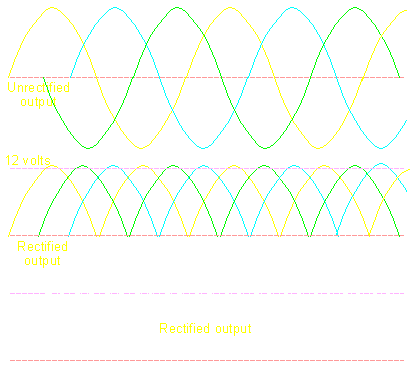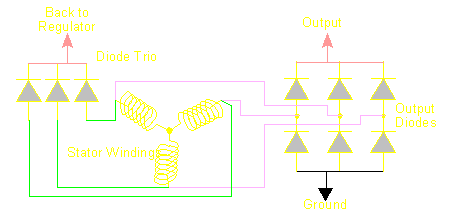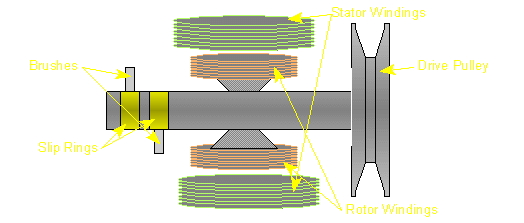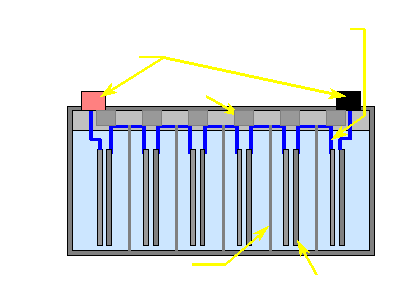- Charging System Basics:
- The electrical system in an
automobile is said to be a 12 volt system, but
this is slightly misleading. The charging system
in most cars will generally produce a voltage
between 13.5 and 14.4 volts while the engine is
running. It has to generate more voltage than the
battery's rated voltage to overcome the internal
resistance of the battery. This may seem strange,
but the current needed to recharge the battery
would not flow at all if the charging system's
output voltage was the same as the battery
voltage. A greater difference of potential
(voltage) between the battery's voltage and the
alternator's output voltage will provide a faster
charging rate.
- As long as the engine is
running, all
of the power for the accessories is delivered by
the alternator. The battery is actually a load on
the charging system. The only time that the
battery would supply power with the engine
running is when the current capacity of the
alternator is exceeded or when engine is at a
very low idle.
- Alternator Basics
-
- Overview:
- A basic alternator has 2 main
electrical components. The rotor and the stator.
The rotor is the part of the alternator that is
spun by the drive belt. There are a group of
electrical field coils mounted on the rotor. The
stator is the group of stationary coils that line
the perimeter of the inside of the alternator
case. When current (supplied by the voltage
regulator - to be explained later) is flowing in
the rotor's coils, they induce current flow in
the stationary coils. The induced current (and
voltage) is an AC current. To convert this to DC,
the current is passed through a bridge rectifier.
- Stator and Rotor in Action:
- In the following diagram, you
can see three crudely drawn sets of rotors and
stators. In the leftmost diagram (marked 'A'),
you can see the rotor's coil approaching the
stator coil. As the rotor coil approaches the
stator coil, it induces current flow in the
stator coils. This causes an increase in output
voltage. As it approaches the position where the
coils' centers are aligned ('B'), there is no
induced current. When the coils move away from
each other ('C') the induced current flows in the
opposite direction and the generated voltage is
negative.

- Rectification:
- You should have noticed that
the generated voltage was AC. You already know
that a vehicle's charging system needs to produce
DC to recharge the battery. This is done with
diodes. The following diagram shows a simple
transformer and a bridge rectifier. The
transformer is driven with a sine wave (similar
to that produced in each stator coil). Since the
transformer is driven with a sine wave, the
output of the transformer is a sine wave (similar
to the one shown). The sine wave is driven into
the bridge rectifier and the output is a pulsed
DC waveform.

- Bridge rectifier:
- You should also realize that
there are 3 different groups of stator coils in
an alternator (not shown in diagrams). The
rectification is much like the simple transformer
shown above but in the place of a single
transformer winding there are 3 windings. It also
uses 6 diodes instead of 4.
- 3 Phase:
- The following diagram shows the
3 different phases from the 3 groups of stator
windings. The three phases of AC are shown in
three different colors. The next set of lines
shows the rectified waveforms overlapped. The
bottom waveform (white line) is what the
rectified voltage would actually look like if
viewed on an oscilloscope. Connecting the battery
to the alternator will smooth the white line even
more.

- Alternator Schematic:
- The following is a generic
schematic showing the stator windings and the
bridge rectifier. You also see a diode trio. the
diode trio takes part of the output and sends it
to the voltage regulator. The output diodes are
the rectifiers that rectify the AC and supply
power to your electrical accessories.

- Brushes and Slip Rings:
- For an alternator to produce
electrical current, there needs to be some
excitation current flowing in the rotor windings.
Since the rotor is spinning, you can't just
connect a couple of wires to it (cause they'd
just be twisted off :-). To make the electrical
connection, slip rings and brushes are used. The
slip rings are fixed to the shaft of the rotor.
The brushes are fixed to the stationary part of
the alternator. The brushes, which are generally
made of carbon, are spring loaded to keep
constant pressure on the slip rings as the
brushes wear down. The following diagram shows
the general location of the rotor and the
associated parts.

- Voltage Reguation:
- As you already know from the 'wire' page, all wire has resistance. You
also know that when you have current flow through
a resistive element (wire), there will be a
voltage loss. If the current draw from the
charging system was constant, there would be no
need for a voltage regulator. If there was no
loss, the design engineer would simply design the
alternator to produce a given voltage. This won't
work with a car audio system because the current
draw is anything but constant. This means that
the alternator needs a compensating voltage
regulator. The voltage regulator controls the
flow of current in the rotor's windings. The
voltage regulator's output current will typically
be between 0 amps (with little or no current
draw) and 5 amps (at maximum current draw). The
regulator can vary the current flow infinitely to
keep the voltage precisely at the target voltage.
Generally the regulator is built into the
alternator. There are some high current/special
use alternators which may have external
regulators. Some of the external regulators are
adjustable via a potentiometer.
- Current demand and flow:
- If you have an alternator that
can produce 120 amps of current (max) and the the
total current demand from the electrical
accessories (including the battery) is only 20
amps, the alternator will only produce the
necessary current (20 amps) to maintain the
target voltage (which is determined by the
alternator's internal voltage regulator).
Remember that the alternator monitors the
electrical system's voltage. If the voltage starts to fall below
the target voltage (approximately 13.8 volts
depending on the alternator's design), the
alternator produces more current to keep the
voltage up. When the demand for current is low,
the full current capacity of the alternator is
not used/produced (a 120 amp alternator does not
continuously produce 120 amps unless there is a
sufficient current draw).
- Dimming lights:
- When you play your system at
very high volumes and the lights on your vehicle
dim slightly, it generally means that your
alternator can not supply enough current for all
of your electrical accessories (including your
amplifiers). If you play a long bass note/tone
and the lights get dim and stay dim until the
note is over, your alternator clearly can not
keep up with the current demand. If, on a long
bass note, the lights dim just for a fraction of
a second but return to their original brightness
while the note/tone is still playing, the
alternator's regulator may just be a little slow
in reacting to the voltage drop. Since the lights
return to their original brightness during the
bass note, the alternator is able to supply the current needed by
your power your amplifiers and other electrical
accessories.
Warning!
- Some people tell you that you
can check your alternator by disconnecting it
from the battery to see if the alternator can
produce enough current to keep the engine
running. BAD IDEA!
Disconnecting the battery will subject the
voltage regulator (and computer and audio
equipment...) to significant voltage spikes which
may cause an otherwise good alternator to fail.
Even if there were no damaging spikes, this test
would not indicate whether or not the alternator
was good because the engine will easily run with
a weak or failing alternator.
- Simple Test:
- If you want to see if your
alternator is producing current, turn on your
headlights when you're parked and the engine
idling with the headlights shining on a wall (at
night). Notice how bright they are. Then turn the
engine off. The lights should get dimmer when you
turn the engine off. If the lights get brighter
when you kill the engine, the alternator was not
charging sufficiently. When doing this test, the
lights should be the only load (turn the stereo,
a/c and other accessories off). With a heavy
load, an otherwise good alternator may not be
able to produce sufficient amounts of current at
idle.
Basic Battery
Information
- Battery Construction:
- A standard 12 volt cranking
battery has 6 individual cells. Each cell is
designed to produce ~2.1 volts. The cells are
connected in series for a total of about 12.5
volts. Each cell basically consists of 1 set of
lead plates and 1 set of lead plates coated with
lead dioxide submerged in a sulfuric acid
electrolytic solution.

- Electrolyte Levels:
- The level of the electrolyte
should be about 1/8" below the bottom of the
filling wells. If the electrolyte is above the
bottom of the well, it may be forced out when the
battery is charged. If the electrolyte is allowed
to fall to below the top of the plates, the
battery will be damaged. If the level of the
electrolyte is low, refill it with distilled
water only. Regular tap water has minerals which
may coat the plates and reduce the battery's
capacity.
- Distilled Water:
- Distilled water is water that's
been heated to cause it to evaporate into water
vapor. The water vapor is then condensed back
into liquid water. The distilled water is free of
all impurities including minerals that would coat
the plates of the battery and therefore reduce
its capacity to produce electrical current.
- Cranking Amps:
- Cranking amps is the spec that
tells you how much current a battery can produce
for 30 seconds at a temperature of 32° F and not
have the voltage on any of the individual cells
drop below 1.2 volts (7.2 volts for a 6 cell
automotive battery). This may also be known as
MCA or marine cranking amps.
- Cold Cranking Amps:
- This is the same test as
cranking amps but is done at 0° F. The CCA spec
is especially important if you live in a really
cold climate. Since the chemical reaction that
produces electrical current in the battery slows
down as the temperature drops, the battery can
produce less current at colder temperatures
(especially below freezing). When comparing the
current capacity of batteries, make sure that you
have some standards to qualify the current
ratings. If you see the current rating without CA
or CCA, you don't know how the battery was tested
and the current rating is virtually useless.
- Reserve Capacity:
- The reserve capacity is the
time that a battery can produce 25 amps at 80° F
before the individual cell voltage drops below
1.75 volts (10.5 volts for a 6 cell automotive
battery).
- Deep Cycle vs Standard Battery:
- A normal lead-acid
battery will be damaged if it is
completely drained (even if it's only one
time).
- A deep cycle battery is
designed to survive being drained
multiple times.
- Deep cycle batteries
have more reserve capacity but have less
cranking amps for a given size.
- A standard battery
would have more total surface area on its
plates when compared to a deep cycle
battery of equal size. This extra surface
area provides more area for the chemical
reaction to take place and therefore
produce a higher output current.
- The electrolyte in a
deep cycle will be a slightly more
concentrated sulfuric acid than a
standard battery.
- Gel-cell Batteries:
- Gel-cell batteries use a
thickened (gelled) electrolyte that will not leak
out like a liquid electrolyte. Many of them can
be mounted in virtually any position. These
batteries may be suitable for some applications
but for engine starting, other batteries should
be used. Gel-cell batteries can not produce as
much current for long periods of time as standard
liquid electrolye batteries.
- Recombinant Gas Batteries:
- RG batteries have only 2 long
thin plates per cell. They are constructed much
like an electrolytic capacitor. The plates are separated by a
fiberglass mat material designed to hold the
electrolyte. These long thin plates have
significant amounts of surface area (compared to
standard batteries). This extra surface area
allows the battery to produce significantly more
current than standard batteries of similar
physical size. Optima® is one manufacturer of RG batteries.
If you're going to add batteries to your system
and the batteries will be in the vehicle's trunk
or passenger compartment, RG batteries won't vent
flammable hydrogen gas or corrosive gasses into
the vehicle.
- Group Size:
- The battery group size is an
indicator of the battery's physical dimensions.
|